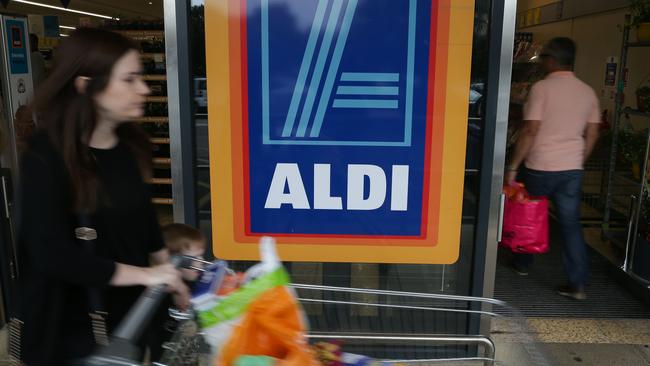Aldi’s onslaught on Australian retail may be slowing
After rapid growth, increasing sales is proving harder for Aldi as it nears critical mass in the east, and faces hurdles in the west.

Easy pickings for supermarket discounter Aldi in the nation’s $90 billion grocery sector are becoming harder to come by, as its aggressive store rollout on the east coast reaches “critical mass”.
This will come as a relief to Woolworths and Coles, which have watched billions of dollars in earnings flow to the German retailer.
For the first time in decades, since Aldi first arrived in Australia, its stores are starting to cannibalise from each other. Under this scenario, Aldi stores in the same city end up taking trade from each other.
This is even happening in South Australia and Western Australia, where Aldi is new to the markets, and it is putting pressure back on the retailer to draw better sales from its existing stores through refurbishments and a higher quality fresh food offer.
It means that after Aldi’s relentless onslaught on incumbents like Woolworths, Coles and wholesaler Metcash, the German chain could now find its own pace of sales growth starting to slow and its competitive threat even plateauing.
A new report on Aldi’s growth trajectory by UBS argues Aldi is reaching “critical mass” on the east coast, where it has the bulk of its near-500 stores, while in South Australia and Western Australia a larger-than-expected number of new stores are cannibalising each other.
The faster rate of cannibalisation in the new regions will be of particular worry to Aldi but a relief to players like Woolworths and Coles, who have been bracing for a competitive battle in South Australia and Western Australia, as shoppers are won over by the novelty of the Aldi shopping model.
Since Aldi launched in Australia in 2001 it has built up its annual sales to nearly $8 billion and captured a 10 per cent slice of the grocery sector from the existing supermarket giants and smaller independents.
But now the tide could be turning, or at the very least its intensity beginning to wane.
“Our 2nd UBS Evidence Lab Grocery Competition Monitor suggests the competitive impact of Aldi’s store rollout in SA/WA will be less than expected given the percentage of Coles/Woolworths/IGA stores currently competing with Aldi in SA/WA is not too dissimilar than the east-coast,’’ said UBS analyst Ben Gilbert.
“And a surprisingly large (accelerating) number of Aldi stores are cannibalising each other, around 63 per cent of store fleet relative to the more mature east-coast market of around 78 per cent.’’
Mr Gilbert said Aldi cannibalisation is high in both its core east coast markets as well as in South Australia and Western Australia, despite just “early days” in those states.
“Despite less than half the penetration of the east-coast, a larger than expected number of Aldi SA/WA stores are cannibalising each other, with this impact accelerating in the fourth quarter of calendar 2017.
“We find this as surprising, given Aldi has only recently entered the SA/WA market in 2016,’’ Mr Gilbert added, “and suggests downside risk to store aspirations for around 120 stores
(versus around 57 currently).
“This is positive from an industry perspective; particularly considering the limited store rollout opportunity for Aldi in the east coast.”
Aldi has set out ambitious growth plans for the east coast as well as its recent move into South Australia and Western Australia, with the German supermarket chain also recently unveiling a $500 million refurbishment plan that would see every Aldi store in the country upgraded to a new format.
But UBS believes there now could be risks to Aldi’s medium-to-long-term store targets as cannibalisation across its east coast network increases, making new sales from just opening a new store harder than before.
Mr Gilbert argues this will force Aldi to identify other sources of new sales, namely improving its fresh offer at existing stores — supported by the refurbishment program — and encouraging shoppers to buy more when they visit an Aldi store.
“Aldi (is) finding it harder to grow in both SA/WA and east coast.
“Our study also reiterates Aldi’s impact on market growth from a space perspective is moderating, with store targets looking more challenging to achieve.”
Australia has proved a goldmine for Aldi, with recent Australian Taxation Office figures showing its sales jumped $1 billion to $5.8 billion for calendar year 2014, as pre-tax earnings hit $238.5 million. It is estimated its sales will tip over $8 billion this year. Six years ago, Aldi’s sales were only $3.14 billion.





To join the conversation, please log in. Don't have an account? Register
Join the conversation, you are commenting as Logout